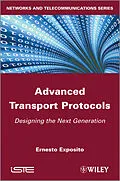The current diversity of transport services, as well as the complexity resulting from the deployment of specific transport protocols or mechanisms over the different services provided by heterogeneous networks, demand a novel design of the transport layer. Moreover, current and future applications will only be able to take advantage of the most adapted and available transport services if they are able to interact (i.e. discover, compose, deploy and adapt) efficiently with this advanced transport layer.The work presented in this book proposes a model-driven methodology and a service-oriented approach aimed at designing the mechanisms, functions, protocols and services of the next generation transport layer.The first part of this book presents the state of the art of transport protocols and introduces a model-driven methodology and an ontology semantic model implementation aimed at designing next generation transport protocols.The second part presents the UML-based design of a component-based transport protocol. An extension to this protocol based on service-component and service-oriented architectures is also presented.The third part presents various model-driven adaptive strategies aimed at managing the behavioral and structural adaptation of next generation autonomic transport protocols.The fourth and final part presents the design of a transport layer based on component-oriented and service-oriented approaches and integrating the autonomic computing paradigm guided by the semantic dimension provided by ontologies.
Autorentext
Ernesto exposito is Associated Professor at Institut National des Sciences Appliquées (INSA) de Toulouse
Researcher at "Laboratoire d'Analyse et d'Architecture des Systèmes" (LAAS) du CNRS, team SARA.
Inhalt
Preface xi
Chapter 1. Introduction 1
1.1. Evolution of application and network layers 1
1.2. Summary of contributions 3
1.3. Book structure 5
Chapter 2. Transport Protocols State of the Art 7
2.1. Introduction7
2.2. Transport layer reference models 9
2.2.1. OSI model 9
2.2.2. TCP/IP model 9
2.2.3. Transport layer 9
2.2.4. Transport services 10
2.3. Transport functions and mechanisms 11
2.3.1. Error control 11
2.3.2. Congestion control 14
2.3.3. Summary 19
2.4. IETF transport protocols 20
2.4.1. TCP 20
2.4.2. UDP21
2.4.3. SCTP 21
2.4.4. DCCP 22
2.4.5. MPTCP 23
2.5. Summary 23
Chapter 3. Semantic Modeling of Transport Protocols and Services 25
3.1. Introduction 25
3.2. Model and semantic-driven architecture 26
3.2.1. Model-driven architecture 26
3.2.2. Ontology-driven architecture 27
3.3. Design of a QoS ontology framework 28
3.3.1. Quality of Service definition 28
3.3.2. ITU-T X.641 framework 29
3.3.3. Service 29
3.3.4. Service user . 29
3.3.5. Service provider30
3.3.6. QoS characteristic 30
3.3.7. QoS requirement . 30
3.3.8. QoS parameter 30
3.3.9. QoS function. 31
3.3.10. QoS mechanism . 31
3.4. Design of a QoS transport ontology for the next generation
transport layer . 31
3.4.1. Ontology representation 31
3.4.2. X.641 QoS ontology . 32
3.4.3. QoS transport requirements 33
3.4.4. QoS transport mechanisms, functions and protocols . 33
3.5. QoS transport ontology specification. 34
3.5.1. TCP semantic description . 34
3.5.2. UDP semantic description. 36
3.5.3. SCTP semantic description 36
3.5.4. DCCP semantic description 38
3.5.5. MPTCP semantic description . 40
3.6. Usage of the QoS transport ontology specification 41
3.6.1. QoS transport services characterization 42
3.6.2. Transport components and transport composite
characterization 45
3.7. Summary 46
Chapter 4. Model-Driven Design Methodology of Transport
Mechanisms and Functions 49
4.1. Introduction49
4.2. Software engineering process 50
4.2.1. Unified Modeling Language 51
4.2.2. UML 2.4.1-based methodology 52
4.2.3. UML diagrams 55
4.2.4. Summary and additional resources 66
4.3. Applying the UML-based software engineering methodology
for transport services 68
4.3.1. Contextual model of transport functions and mechanisms 68
4.3.2. Analysis of requirements guiding transport functions 69
4.3.4. Design of transport functions and mechanisms 71
4.4. Summary 77
Chapter 5. Model-Driven Specification and Validation
of Error Control Transport Mechanisms and Functions 79
5.1. Introduction 79
5.2. Design of an error control function 80
5.2.1. Behavior specification of the sending side protocol entity 81
5.2.2. Behavior specification of the receiving side protocol entity 83
5.3. Functional validation of the error control function 84
5.3.1. Functional validation using a perfect medium 86
5.3.2. Functional validation using an imperfect medium 88
5.4. A new design of the error control function 93
5.4.1. Functional validation using an imperfect medium 96
5.4.2. More open questions 97
5.5. A model-driven simulation environment 98
5.5.1. Model-driven simulation framework 99
5.5.2. Model-driven network simulator package 100
5.5.3. Lossy medium simulator 101
5.5.4. Delayed medium simulator 102
5.5.5. Bandwidth-limited medium simulator 104
5.6. Chapter summary 106
5.7. Appendix 107
Cha...
